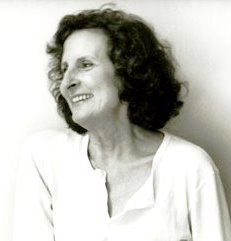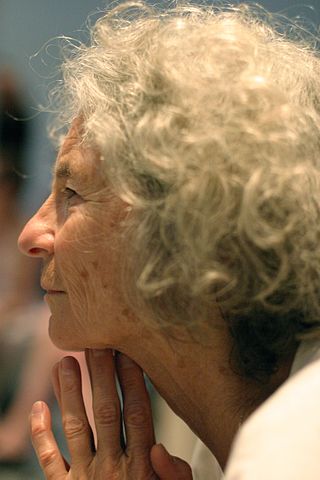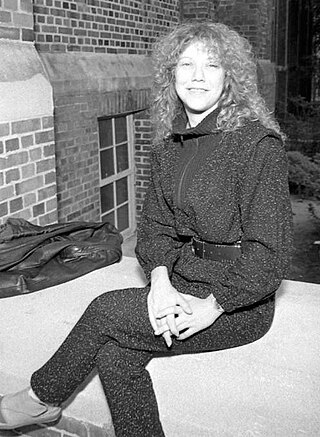Related Research Articles

Choreography is the art or practice of designing sequences of movements of physical bodies in which motion or form or both are specified. Choreography may also refer to the design itself. A choreographer is one who creates choreographies by practising the art of choreography, a process known as choreographing. It most commonly refers to dance choreography.

Postmodern art is a body of art movements that sought to contradict some aspects of modernism or some aspects that emerged or developed in its aftermath. In general, movements such as intermedia, installation art, conceptual art and multimedia, particularly involving video are described as postmodern.

Mercier Philip "Merce" Cunningham was an American dancer and choreographer who was at the forefront of American modern dance for more than 50 years. He frequently collaborated with artists of other disciplines, including musicians John Cage, David Tudor, Brian Eno, and graphic artists Robert Rauschenberg, Bruce Nauman, Andy Warhol, Roy Lichtenstein, Frank Stella, and Jasper Johns; and fashion designer Rei Kawakubo. Works that he produced with these artists had a profound impact on avant-garde art beyond the world of dance.
Dance improvisation is the process of spontaneously creating movement. Development of movement material is facilitated through a variety of creative explorations including body mapping through levels, shape and dynamics schema.

Contemporary dance is a genre of dance performance that developed during the mid-twentieth century and has since grown to become one of the dominant genres for formally trained dancers throughout the world, with particularly strong popularity in the U.S. and Europe. Although originally informed by and borrowing from classical, modern, and jazz styles, it has come to incorporate elements from many styles of dance. Due to its technical similarities, it is often perceived to be closely related to modern dance, ballet, and other classical concert dance styles.
Judson Dance Theater was a collective of dancers, composers, and visual artists who performed at the Judson Memorial Church in Greenwich Village, Manhattan New York City between 1962 and 1964. The artists involved were avant garde experimentalists who rejected the confines of Modern dance practice and theory, inventing as they did the precepts of Postmodern dance.

Yvonne Rainer is an American dancer, choreographer, and filmmaker, whose work in these disciplines is regarded as challenging and experimental. Her work is sometimes classified as minimalist art. Rainer currently lives and works in New York.

Trisha Brown was an American choreographer and dancer, and one of the founders of the Judson Dance Theater and the postmodern dance movement. Brown’s dance/movement method, with which she and her dancers train their bodies, remains pervasively impactful within international postmodern dance.

Steve Paxton is an experimental dancer and choreographer. His early background was in gymnastics while his later training included three years with Merce Cunningham and a year with José Limón. As a founding member of the Judson Dance Theater, he performed works by Yvonne Rainer and Trisha Brown. He was a founding member of the experimental group Grand Union and in 1972 named and began to develop the dance form known as Contact Improvisation, a form of dance that utilizes the physical laws of friction, momentum, gravity, and inertia to explore the relationship between dancers.

David Gordon was an American dancer, choreographer, writer, and theatrical director prominent in the world of postmodern dance and performance. Based in New York City, Gordon's work has been seen in major performance venues across the United States, Europe, South America and Japan, and has appeared on television on PBS's Great Performances and Alive TV, and the BBC and Channel 4 in Great Britain.
Deborah Hay is an American choreographer, dancer, dance theorist, and author working in the field of experimental postmodern dance. She is one of the original founders of the Judson Dance Theater. Hay's signature slow and minimal dance style was informed by a trip to Japan while touring with Merce Cunningham's company in 1964. In Japan she encountered Noh theatre and soon incorporated nô's extreme slowness, minimalism and suspension into her post-Cunningham choreography. Sometimes she also imposed stressful conditions on the dancers, as with her "Solo" group dance that was presentation at 9 Evenings: Theatre and Engineering.
American avant-garde composer John Cage (1912–1992) began composing pieces for solo prepared piano around 1938–40. The majority of early works for this instrument were created to accompany dances by Cage's various collaborators, most frequently Merce Cunningham. In response to frequent criticisms of prepared piano, Cage cited numerous predecessors. In the liner notes for the very first recording of his most highly acclaimed work for prepared piano, Sonatas and Interludes, Cage wrote: "Composing for the prepared piano is not a criticism of the instrument. I'm only being practical." This article presents a complete list of Cage's works for prepared piano, with comments on each composition. All of Cage's indeterminate works for unspecified forces can also be performed on or with Prepared Piano.
Kenneth King is an American post-modern dancer and choreographer who is best known for his experimentations with dance and multimedia. A second-generation Judson Dance Theatre choreographer, much of King's experimental dance repertoire combines different movements styles with dramatic material and technological advances, emphasizing the importance of the human body through expressionism and symbolism.
Lucinda Childs is an American postmodern dancer/choreographer and actress. Her compositions are known for their minimalistic movements yet complex transitions. Childs is most famous for being able to turn the slightest movements into intricate choreography. Her use of patterns, repetition, and dialect has caused her to have a unique style of choreography that is often imitated for its ability to experiment.

Simone Forti, is an American Postmodern artist, dancer, choreographer, and writer. Since the 1950s, Forti has exhibited, performed, and taught workshops all over the world. Her innovations in Postmodern dance, including her seminal 1961 body of work, Dance Constructions, along with her contribution to the early Fluxus movement, have influenced many notable dancers and artists. Forti first apprenticed with Anna Halprin in the 1950s and has since worked alongside artists and composers Nam June Paik, Steve Paxton, La Monte Young, Trisha Brown, Charlemagne Palestine, Peter Van Riper, Dan Graham, Yoshi Wada, Robert Morris and others. Forti's published books include Handbook in Motion, Angel, and Oh Tongue. She is currently represented by The Box L.A. in Los Angeles, CA, and has works in the permanent collections of the Museum of Modern Art (MOMA) in New York, the Stedelijk Museum in Amsterdam, the Generali Foundation in Vienna, the Whitney Museum of American Art in New York, and the Moderna Museet in Stockholm.
Gus Solomons Jr. is an accomplished dancer, choreographer, dance critic, and actor. He is a leading figure in postmodern and experimental dance.

Modern dance is a broad genre of western concert or theatrical dance which included dance styles such as ballet, folk, ethnic, religious, and social dancing; and primarily arose out of Europe and the United States in the late 19th and early 20th centuries. It was considered to have been developed as a rejection of, or rebellion against, classical ballet, and also a way to express social concerns like socioeconomic and cultural factors.
Robert Ellis Dunn was an American musician and choreographer who led classes in dance composition, contributing to the birth of the postmodern dance period in the early 1960s in New York City.

Sally Rachel Banes was a notable dance historian, writer, and critic.

James Waring was a dancer, choreographer, costume designer, theatre director, playwright, poet, and visual artist, based in New York City from 1949 until his death in 1975. He was a prolific choreographer and teacher. He has been called "one of the most influential figures in the New York avant-garde in the late fifties and early sixties", "one of dance's great eccentrics", "a focal point for dance experimentation before the existence of the Judson Dance Theater", and "the quintessential Greenwich Village choreographer in the late 1950s and 1960s". Waring's collage style of building dance works influenced the development of the avant-garde Happenings which were staged in the late 1950s.
References
Notes
- 1 2 3 4 5 6 7 8 9 10 Bertens, Hans; Fokkema, Douwe W. (1997). International Postmodernism: Theory and literary practice. John Benjamins Publishing. ISBN 978-90-272-9971-0.[ page needed ]
- 1 2 Cohen, Selma Jeanne (1998). International Encyclopedia of Dance. Oxford University Press. ISBN 978-0-19-509462-6. OCLC 37903473.[ page needed ]
- 1 2 3 4 Banes, Sally (1987). Terpsichore in Sneakers: Post-Modern Dance. Wesleyan University Press. ISBN 978-0-8195-7180-9. OCLC 48139465.[ page needed ]
- 1 2 3 Minton, Sandra (2007). Choreography: A Basic Approach Using Improvisation. Human Kinetics Publishers. p. 53. ISBN 978-0-7360-6476-7.
- 1 2 3 4 5 Banes, Sally (2011). Terpsichore in Sneakers: Post-Modern Dance. Wesleyan University Press. ISBN 978-0-8195-6160-2.[ page needed ]
- ↑ İnan, Şükriye (January 2014). "The Effects of Minimalist Movement on Painting, Arts and Music" (PDF). International Journal on New Trends in Education and Their Implications. 5.
- ↑ Kam, Vanessa (2005). "Merce Cunningham in Conversation with John Rockwell". Archived from the original on 28 February 2005.
- ↑ Leader, Jody (April 15, 1987). "Merce Cunningham's Dance Succeeds by Chance". Chicago Tribune.
- 1 2 Copeland, Roger (1983). "Postmodern Dance Postmodern Architecture Postmodernism". Performing Arts Journal. 7 (1): 27–43. doi:10.2307/3245292. JSTOR 3245292. S2CID 194025857.
Further reading
- Banes, S (1987) Terpsichore in Sneakers: Post-Modern Dance. Wesleyan University Press. ISBN 0-8195-6160-6
- Banes, S (Ed) (1993) Greenwich Village 1963: Avant-Garde Performance and the Effervescent Body. Duke University Press. ISBN 0-8223-1391-X
- Banes, S (Ed) (2003) Reinventing Dance in the 1960s: Everything Was Possible. University of Wisconsin Press. ISBN 0-299-18014-X
- Bremser, M. (Ed) (1999) Fifty Contemporary Choreographers. Routledge. ISBN 0-415-10364-9
- Carter, A. (1998) The Routledge Dance Studies Reader. Routledge. ISBN 0-415-16447-8
- Copeland, R. (2004) Merce Cunningham: The Modernizing of Modern Dance. Routledge. ISBN 0-415-96575-6
- Denby, Edwin "Dancers, Buildings, and People in the Streets".(1965) Curtis Books. ASIN B0007DSWJQ
- Reynolds, N. and McCormick, M. (2003) No Fixed Points: Dance in the Twentieth Century. Yale University Press. ISBN 0-300-09366-7